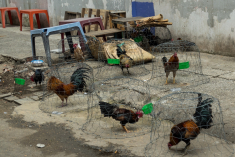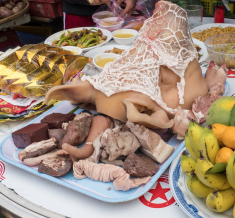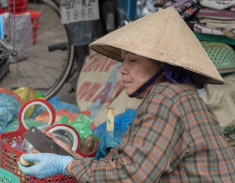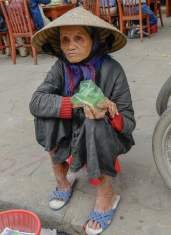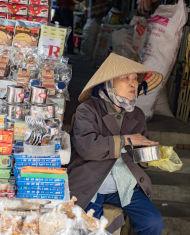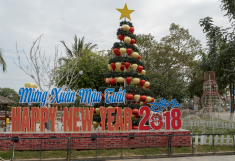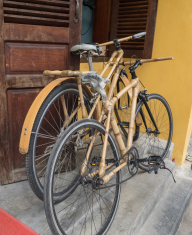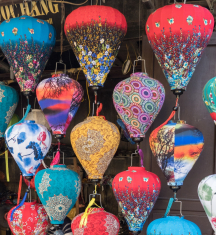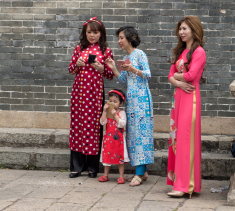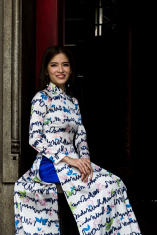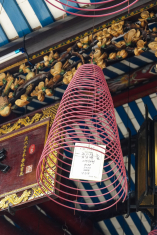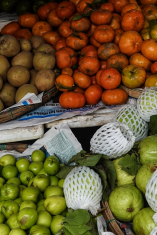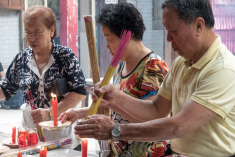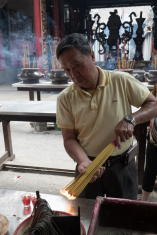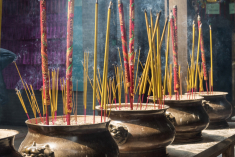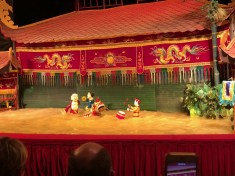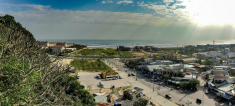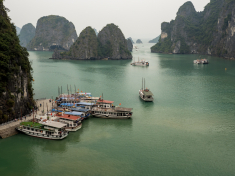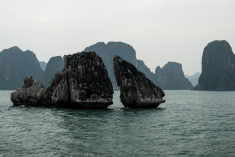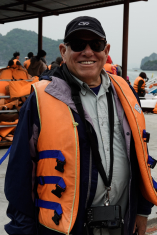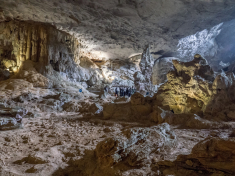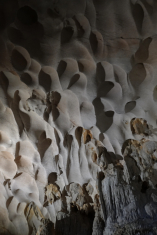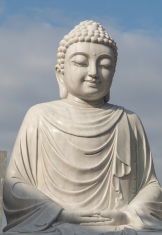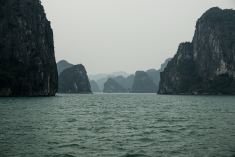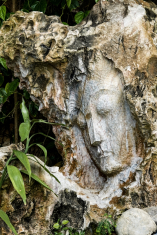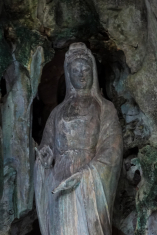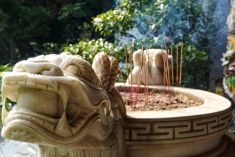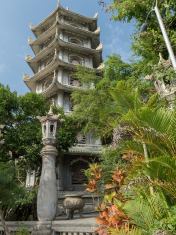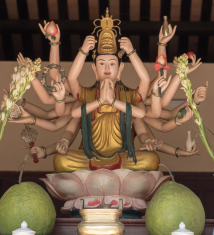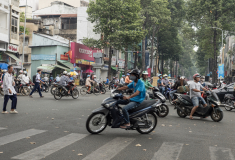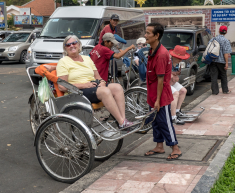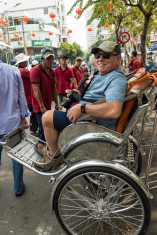Trip Report, Part Deux . . . . . We embarked on another Dam ship (Holland America Volendam) for a 28 day journey, down the coast of Vietnam, quickly in and out of Thailand, and Singapore, then another 2 weeks in Indonesia. Here is what we saw in Vietnam . . .
In northern Vietnam, Halong Bay is a collection of some 1,600 limestone monoliths (up to 300 feet high), so breathtaking it was designated a world heritage site by UNESCO in the mid 1990’s. We experienced Halong in all its natural beauty by boat. Even though the weather was not at its best, the boat motored along and brought us to Hang Dau Go – meaning wooden stakes cave – which is the largest cave with three soaring chambers filled with a plethora of stalactites and stalagmites. With the mist, the islands looked ethereal. We were lucky, and spotted wild monkeys playing on the cliffs along the way.
From Da Nang, we spent the day at Marble Mountain. A cluster of five hills made from limestone and marble, they are named after the elements metal, wood, fire, water and earth. Artists extract marble from the mountain and so this is a center for sculpture and stone cutting. The tour took us there to see if we wanted to order anything, — special price for you — we ship anywhere in the world! Everyone needs a 15 foot Buddha for their garden!
During the Vietnam war (known in Vietnam as the “War of American Aggression”) the jungle covered marble mountains were a hideout for the Northern soldiers who used the natural camouflage to shoot at airplanes flying over Da Nang, spy on soldiers working at the military base or relaxing on China Beach below; you can still see bullet holes.
Now it has returned to a Buddhist Sanctuary, with many pagoda temples (some dating back to the 17th century). The tall pagoda is Pho Dong built in 1825. Many other caves and grottos, with the requisite alters and incense, carry the peaceful, prayerful, atmosphere that you would find in places of worship.
We had lunch in Hoi An, a local restaurant served the best Pho I have ever tasted. (Pho is like chicken noodle soup.) The old town is Hoi An’s main attraction, the Venice of Vietnam. Chinese lanterns float above alleyways and canals are flanked by shopfronts, so picturesque it almost looks like a film set! The city consists of three short streets running parallel to the sleepy river.
Hoi An has a history of attracting outsiders; from the 16th to the19th century it became one of Asia’s most important trading ports. In return they imprinted a distinct cultural overlay, Japanese arched bridges, French wooden shutters and Chinese Pagodas. The Chinese merchants, from whom many families trace their ancestry today, built community assembly halls, still used by the offspring. This UNESCO World Heritage Site, thankfully banned cars from the old center, a merciful relief after visiting other Vietnamese cities, where crossing the road is akin to Russian roulette. Check out the photo of the bicycle built out of bamboo.
Nah Trang brought one of our favorite memories from our 2011 trip in Vietnam. Then, and now we enjoyed the day in a mud bath. I know the term mud bath seems paradoxical, how do you bathe in something that makes you dirty? And why would you? Well for one — it gives you a great case of the giggles, mud on your nose, mud on your toes. Secondly, it is part of a beauty regimen, rejuvenate and stimulate skin cells (ok, I read the brochure). Mostly, it was a resort where we could kick back for a couple of hours, we saw no one from the cruise ship, and we could remember when we just traveled thru this region sampling quirky, local ways to spend a day.
Then came Ho Chi Minh City, the beating heart of Vietnam. Architectural highlights include the Saigon Opera House, a flamboyant, rose-tinted building which still hosts events and Notre Dam Cathedral, the 19th century redbrick masterpiece. Another colonial gem is the General Post Office which has been in service since 1880’s. It’s opulent vaulted ceilings are certainly one of the more glamorous places you’ll ever post a letter. Certainly, the Reunification Palace is one of the most perfectly preserved examples of 1960’s government architecture you’ll see anywhere in the world. The Rex Hotel, famous as an American reporters hangout, is literally a block away from the Vietnamese Government Ruling House. All these things are in the “older” District 1, aka as Saigon. HCMC has 13 districts, but most of the sights are concentrated in Saigon (District 1).
We spent much time at Pagoda of the Lady Thien Hau. It is regarded as one of the oldest, largest, and most beautiful temples in HCM City. The temple is dedicated to the Lady of the Sea. People go there to pray for safe travel, which in 1760, was most likely by sea. It is accessed by an iron gate and crossing a small courtyard. The roof is decorated with small, delicately fashioned porcelain figurines expressing themes from Chinese religion and legends. Of course, incense is all about. The cruise coordinator lit an incense for us travelers to continue a good trip. It was so close to Lunar New Year (celebrated starting Feb 13 for 1 week) that many people were dressed in their finest and getting their photo taken, others were making special prayers and presenting gifts as is the custom at this time of year.
Our guide arranged for us to be transported by trishaw, a pedicab, across town, down the flower alley, up the chicken and bird alley, thru a life threatening intersection or two. Wow! The 45 minute rickshaw ride was one of the most incredible experiences — one of sheer fear and exhilaration! It was orchestrated chaos! The drivers were oblivious to red traffic lights, going the wrong way up one way streets and never gave a moments thought to pedestrians who dared to cross the road in front of our madcap drivers. David was the first passenger of our group, he got some great film of near misses and objects that were bigger, faster and noisier than his flimsy contraption of light, rusty metal. It was one of the highlights of our day in Saigon.
Another unexpected highlight was the Water Puppet Theatre. There are a lot of different kinds of puppet shows, but none like this — it has its roots in the 11th century when water puppet theatre was performed in the rice fields with puppets laying over the water. The show is done in a pool of water, and the puppets are controlled by puppeteers hiding behind a bamboo screen. The show consists of short sketches, with colorful characters, who take the audience on a journey to daily life of the farmers: cultivating, tending buffalo, catching fish . . ., to an adaptation of fairy tails and to dances with mythical creatures. This is accompanied by live folk singers and musicians. The whole thing was utterly charming, and showcases Vietnamese traditions preserved for today’s young (and young at heart).
Forty years after millions of Vietnamese were killed in the war, locals bear little animosity toward the US. Vietnamese millennials have grown up without direct experience of what they call “the American War,” though many have lost grandparents in the fighting. They say their parents reminisce but young people are just not interested. Young people in Vietnam grew up in the communist country that the war created. Vietnam has become one of SE Asia’s fastest growing economies. The student textbooks reflect a hard but glorious struggle to defeat the American invaders. They learn that even though the US Army was mighty and their weapons modern, the Vietnamese country united and stood up for their freedom. While the specter of communism drew the United States into the war and communist forces ultimately won it, political ideology means little to the ordinary Vietnamese. Young people care more for their own careers and their own dreams. Still it was jarring to see the hammer and sickle portrayed next to the Vietnamese flag. I guess this is why we travel, keeps you on your toes.



